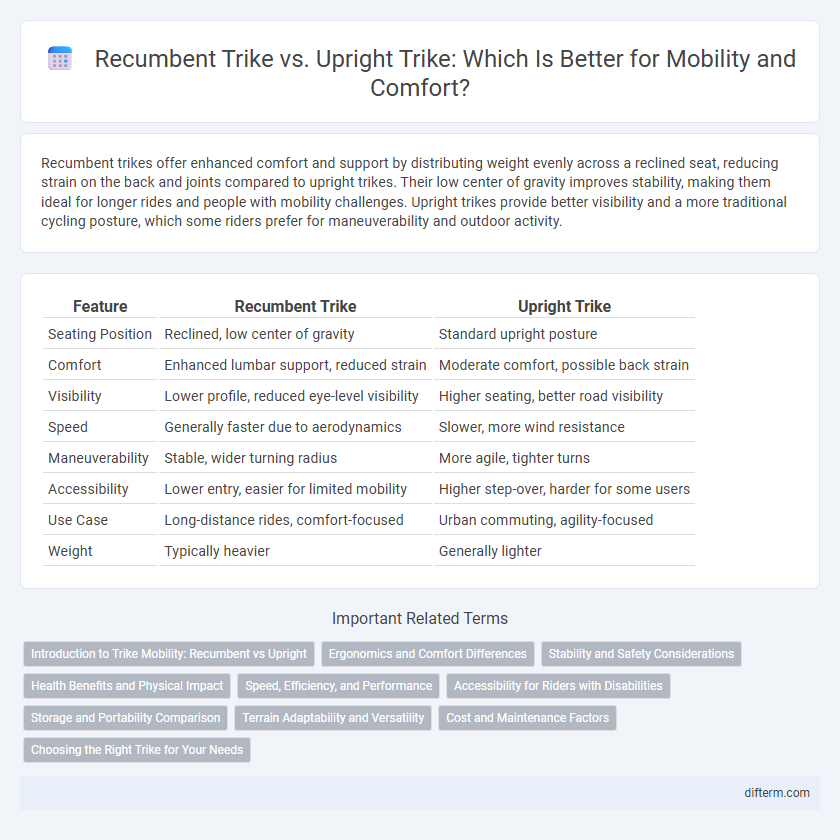Recumbent trikes offer enhanced comfort and support by distributing weight evenly across a reclined seat, reducing strain on the back and joints compared to upright trikes. Their low center of gravity improves stability, making them ideal for longer rides and people with mobility challenges. Upright trikes provide better visibility and a more traditional cycling posture, which some riders prefer for maneuverability and outdoor activity.
Table of Comparison
| Feature | Recumbent Trike | Upright Trike |
|---|---|---|
| Seating Position | Reclined, low center of gravity | Standard upright posture |
| Comfort | Enhanced lumbar support, reduced strain | Moderate comfort, possible back strain |
| Visibility | Lower profile, reduced eye-level visibility | Higher seating, better road visibility |
| Speed | Generally faster due to aerodynamics | Slower, more wind resistance |
| Maneuverability | Stable, wider turning radius | More agile, tighter turns |
| Accessibility | Lower entry, easier for limited mobility | Higher step-over, harder for some users |
| Use Case | Long-distance rides, comfort-focused | Urban commuting, agility-focused |
| Weight | Typically heavier | Generally lighter |
Introduction to Trike Mobility: Recumbent vs Upright
Recumbent trikes offer enhanced ergonomic support with a reclined seating position that reduces strain on the back and neck, making them ideal for long-distance rides and users with mobility challenges. Upright trikes provide a traditional seated posture that promotes better visibility and control, favored by riders seeking a more active and dynamic cycling experience. Both trike types feature stable three-wheel designs but cater to different ergonomic preferences and usage scenarios, influencing comfort, speed, and maneuverability in varied terrains.
Ergonomics and Comfort Differences
Recumbent trikes offer superior ergonomics by providing a reclined seating position that reduces strain on the lower back and distributes weight evenly, enhancing overall comfort during long rides. Upright trikes place the rider in a traditional seated position, which can cause pressure points and fatigue due to increased weight on the saddle and handlebars. Ergonomically, recumbent trikes promote better posture and reduce joint stress, making them ideal for riders seeking comfort and support.
Stability and Safety Considerations
Recumbent trikes offer enhanced stability due to their low center of gravity and three-point ground contact, reducing the risk of tipping during sharp turns or uneven terrain. Upright trikes provide better visibility and easier mounting but may have a higher center of gravity, which can increase the chances of instability during sudden maneuvers. Safety considerations favor recumbent trikes for riders prioritizing balance and reduced fall risk, while upright trikes may suit those valuing agility and quick reaction times.
Health Benefits and Physical Impact
Recumbent trikes offer superior ergonomic support, reducing strain on the lower back and joints compared to upright trikes, which can cause increased pressure on the wrists and spine. The reclined seating position of recumbent trikes promotes improved circulation and muscular engagement without overexerting the upper body, enhancing cardiovascular health while minimizing injury risk. Upright trikes, while beneficial for core strengthening and balance, often result in greater fatigue and impact on the knees and hips, making recumbent trikes a better choice for long-term joint preservation and overall physical comfort.
Speed, Efficiency, and Performance
Recumbent trikes offer superior aerodynamics and reduced wind resistance, resulting in higher speeds and improved energy efficiency compared to upright trikes. Their ergonomic design enhances rider comfort, allowing sustained performance over long distances without excessive fatigue. Conversely, upright trikes provide greater maneuverability and visibility, but generally yield lower top speeds and less efficient power transfer.
Accessibility for Riders with Disabilities
Recumbent trikes offer enhanced accessibility for riders with disabilities due to their low seat height and ergonomic design, which provides better support and comfort during rides. Their stable three-wheel configuration reduces balance challenges, making them ideal for individuals with limited mobility or balance issues. Upright trikes, while providing a traditional cycling posture, may pose difficulties for some riders with disabilities due to higher seat placement and less ergonomic seating.
Storage and Portability Comparison
Recumbent trikes typically offer more compact storage due to their lower profile and foldable designs, making them easier to fit in car trunks or small storage spaces. Upright trikes often have a bulkier frame, which can complicate transportation and require larger storage areas. Portability favors recumbent trikes as their lightweight frames and fold options enhance maneuverability during travel.
Terrain Adaptability and Versatility
Recumbent trikes offer superior stability and comfort on uneven terrain due to their low center of gravity and wider wheelbase, making them ideal for rough trails and off-road conditions. Upright trikes, with their higher seating position, provide better visibility and maneuverability on paved surfaces and urban environments, enhancing versatility in city riding. Terrain adaptability between the two depends on specific needs: recumbent trikes excel on bumpy or hilly terrain, while upright trikes perform well on smoother, flat surfaces.
Cost and Maintenance Factors
Recumbent trikes generally have higher upfront costs due to specialized frames and components, whereas upright trikes tend to be more affordable and widely available. Maintenance for recumbent trikes can be more complex and costly, given their unique parts and less common mechanics, while upright trikes benefit from standard bicycle components that simplify repairs and reduce expenses. Choosing between the two often depends on budget constraints and willingness to manage specific maintenance requirements.
Choosing the Right Trike for Your Needs
When choosing between a recumbent trike and an upright trike, consider comfort and riding style: recumbent trikes offer ergonomic seating that reduces strain on the back and wrists, ideal for longer rides and users with mobility issues. Upright trikes provide a higher riding position that enhances visibility and maneuverability, suited for urban commuting and quick turns. Assess terrain, travel distance, and physical condition to select the trike that best supports your mobility needs.
recumbent trike vs upright trike Infographic

 difterm.com
difterm.com